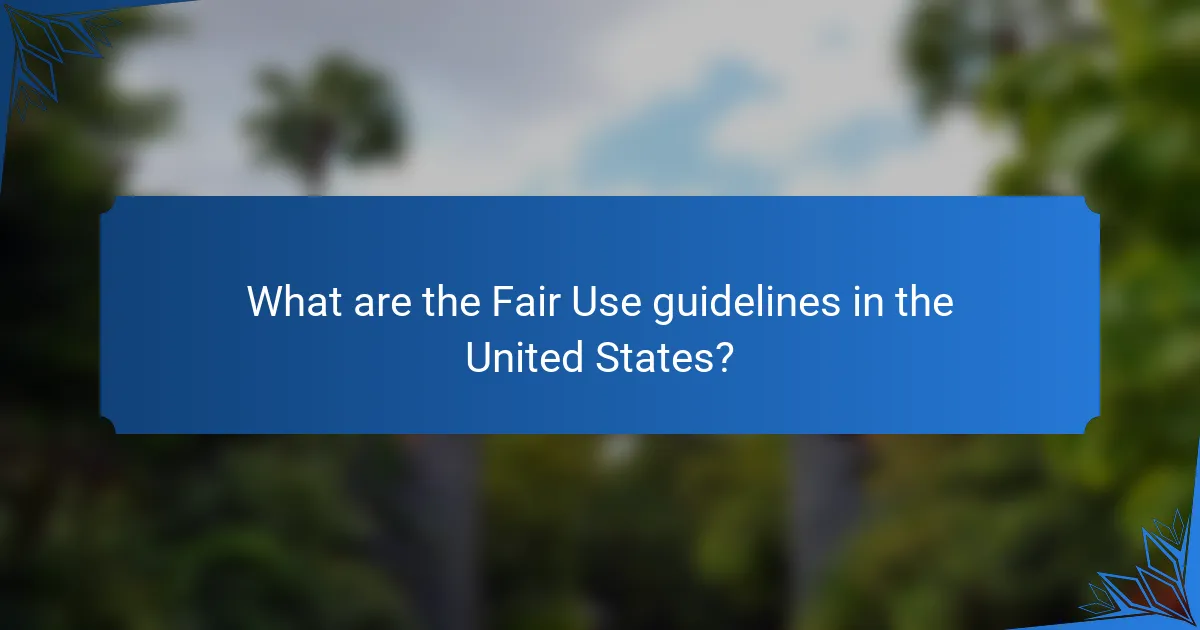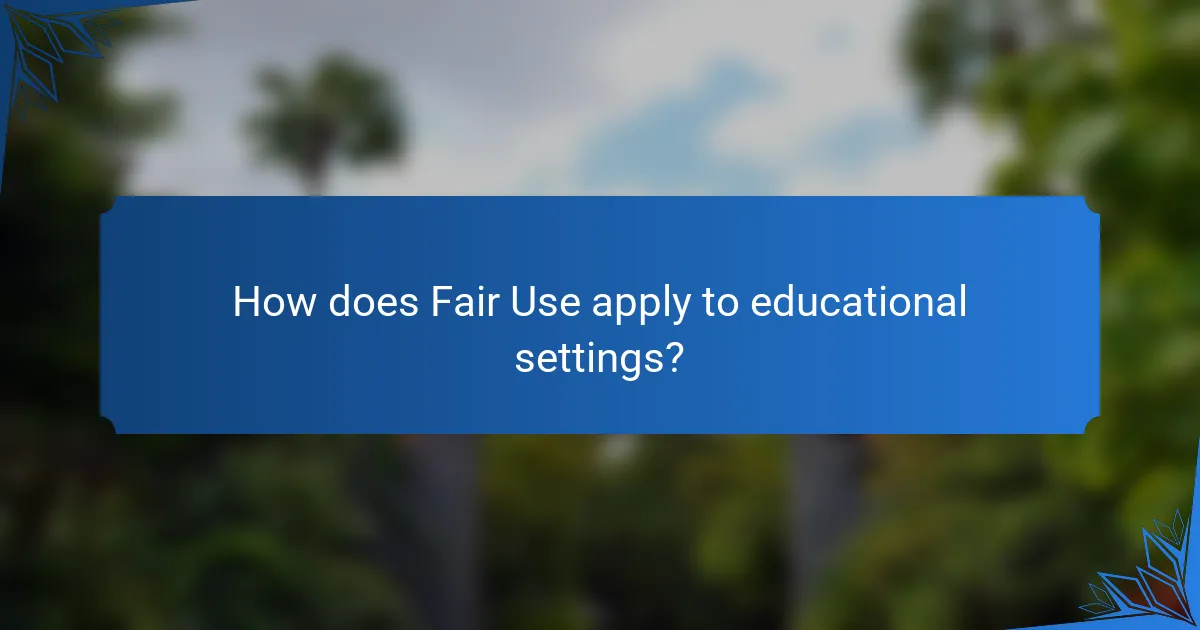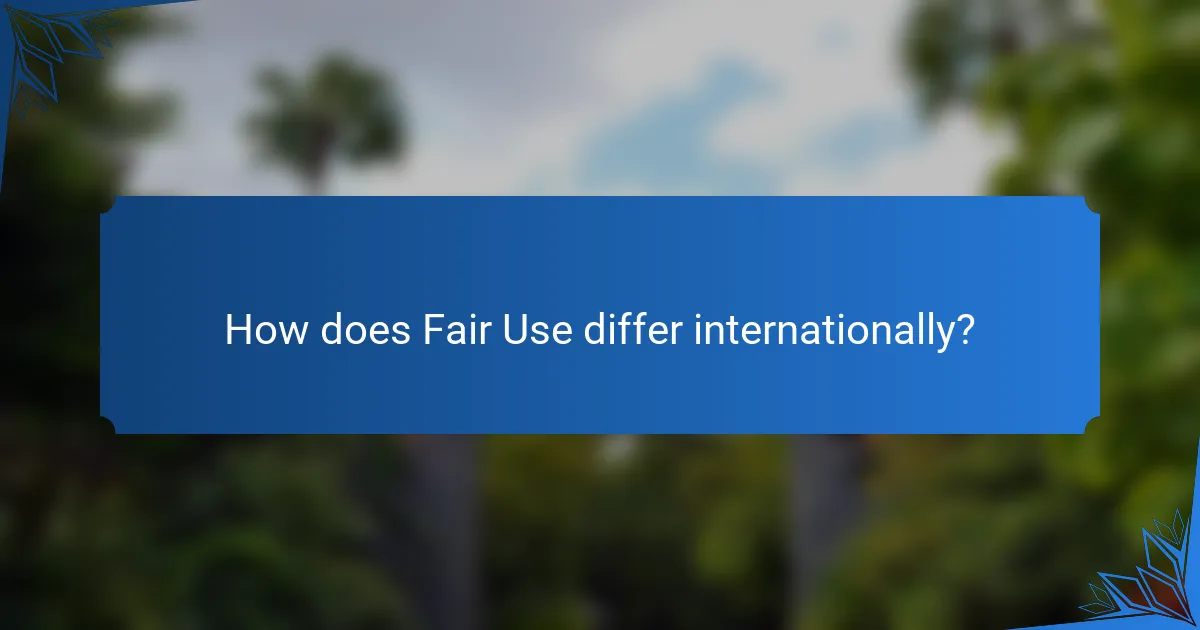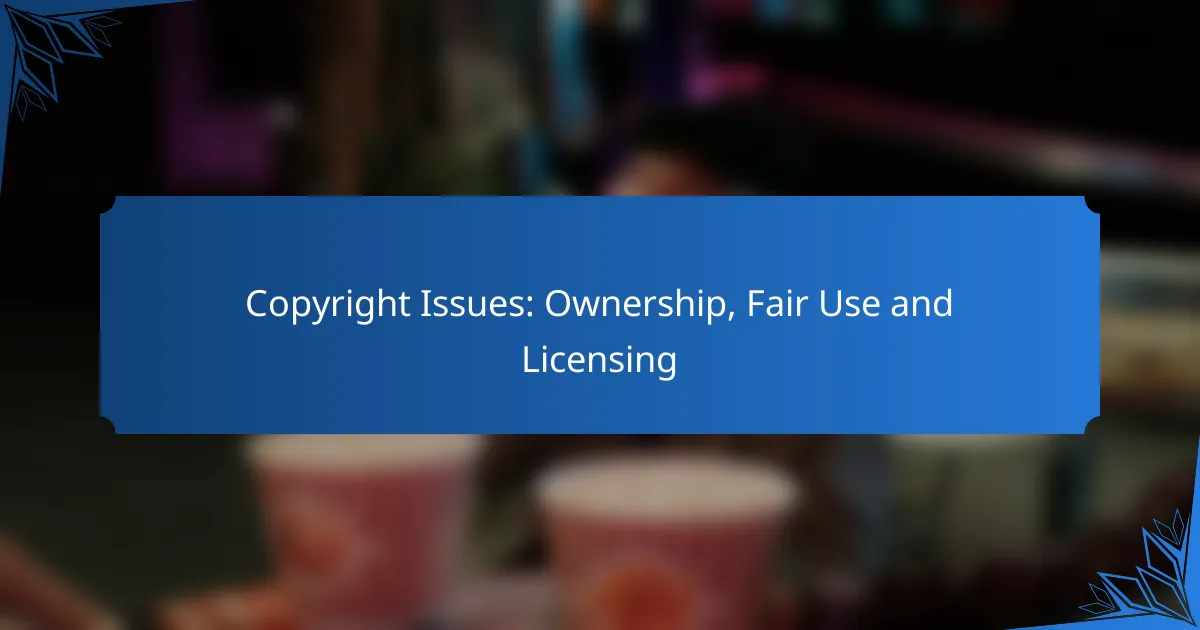Fair Use in the United States permits limited use of copyrighted material without the need for permission from the copyright owner, guided by four essential factors. This legal doctrine is particularly relevant in educational contexts, where it allows for the use of copyrighted works for teaching, scholarship, or research, provided certain conditions are met. Understanding the guidelines and limitations of Fair Use is vital to ensure compliance and effectively leverage available resources.

What are the Fair Use guidelines in the United States?
Fair Use in the United States allows limited use of copyrighted material without permission from the copyright owner. It is determined by four key factors that help assess whether a specific use qualifies as fair under copyright law.
Purpose and character of use
The purpose of the use plays a significant role in determining fair use. Uses that are transformative, such as commentary, criticism, or educational purposes, are more likely to be considered fair. Commercial uses, on the other hand, may face greater scrutiny.
For example, a documentary that includes clips from a film to critique its themes may qualify as fair use, while using the same clips for a promotional video may not.
Nature of the copyrighted work
The nature of the copyrighted work also influences fair use assessments. Published works are generally more likely to be used fairly than unpublished works, as the latter are afforded more protection. Additionally, factual works are more likely to be considered fair use compared to creative works.
For instance, using excerpts from a scientific article for educational purposes may be seen as fair, while using a poem in its entirety for a commercial project may not be.
Amount and substantiality of the portion used
This factor examines both the quantity and the quality of the material used. Using a small portion of a work may favor fair use, but if that portion is considered the “heart” of the work, it may weigh against fair use.
A good rule of thumb is to use only what is necessary for the intended purpose. For example, quoting a few lines from a song for a review may be acceptable, while using the entire song would likely not be.
Effect on the market value
The final factor considers whether the use negatively impacts the market for the original work. If the new use could substitute for the original, it is less likely to be considered fair. This factor is crucial in assessing potential economic harm to the copyright owner.
For example, if a website uses a significant portion of a book for free, thereby reducing sales, this would likely weigh against a fair use claim. In contrast, a brief excerpt used in a scholarly article that does not affect book sales may be more defensible.

How does Fair Use apply to educational settings?
Fair Use allows educators to use copyrighted material without permission under certain conditions, primarily for teaching, scholarship, or research. In educational settings, it is crucial to understand the guidelines and limitations to ensure compliance while maximizing the benefits of available resources.
Classroom use exemptions
In classroom settings, Fair Use typically permits teachers to use copyrighted materials for instructional purposes without seeking permission. This includes using excerpts from books, articles, or videos during lessons, provided the use is limited and directly related to the educational objectives.
For example, showing a short clip from a film to illustrate a concept in a literature class is generally acceptable. However, using an entire film or book would likely exceed Fair Use limits. Educators should aim to use only what is necessary for their teaching goals.
Online course materials
When it comes to online course materials, Fair Use still applies, but there are additional considerations. Educators can share copyrighted content in digital formats, such as PDFs or video links, as long as access is restricted to enrolled students and the use aligns with educational purposes.
For instance, posting a chapter from a textbook on a secure learning management system can be permissible, but it is advisable to provide only a small portion and to include proper citations. Educators should also consider licensing options or public domain resources to avoid potential copyright issues.

What are the limitations of Fair Use?
The limitations of Fair Use primarily revolve around the purpose, nature, amount, and effect of the use on the original work. Understanding these constraints is crucial for anyone looking to utilize copyrighted material without permission.
Commercial use restrictions
Fair Use generally favors non-commercial uses over commercial ones. If the use is primarily for profit, it may weigh against a Fair Use claim. For instance, using a copyrighted image in a blog that generates ad revenue could be seen as commercial, while using it in a personal, educational context is more likely to qualify as fair.
When considering commercial use, assess whether the purpose aligns with educational, non-profit, or transformative goals. If the use is commercial, it is advisable to seek permission from the copyright holder to avoid potential legal issues.
Transformative use criteria
Transformative use refers to how much the new work adds to or changes the original. A work is considered transformative if it provides new expression, meaning, or message. For example, a parody that critiques the original work may qualify as transformative, while simply reproducing the original without significant changes would not.
To determine if your use is transformative, ask whether it alters the original work in a way that adds value or context. This can include commentary, criticism, or educational purposes. Always document how your use transforms the original to strengthen your Fair Use argument.

How can creators ensure compliance with Fair Use?
Creators can ensure compliance with Fair Use by understanding its guidelines and conducting a thorough analysis of their specific use case. This involves evaluating the purpose, nature, amount, and effect of the use on the original work.
Conducting a Fair Use analysis
To conduct a Fair Use analysis, creators should consider four key factors: the purpose of the use, the nature of the original work, the amount used, and the effect on the market value of the original. For instance, using a small excerpt of a book for educational purposes may be more likely to qualify as Fair Use than using a substantial portion for commercial gain.
It’s beneficial to document the analysis process, noting how each factor applies to the specific situation. This can provide a clearer rationale if the use is ever challenged. Additionally, creators should be aware that Fair Use is determined on a case-by-case basis, meaning there are no guarantees.
Seeking permission from copyright holders
If there is uncertainty about whether a use qualifies as Fair Use, seeking permission from copyright holders is a prudent step. This can involve contacting the author or publisher to request a license for the intended use. Many copyright holders are open to negotiation, especially for educational or non-profit purposes.
When seeking permission, be clear about how the work will be used, the duration of use, and the audience. This transparency can facilitate the process and help avoid misunderstandings. Additionally, obtaining permission can provide peace of mind and protect against potential legal issues related to copyright infringement.

What are common misconceptions about Fair Use?
Many people misunderstand Fair Use, believing it offers unlimited freedom to use copyrighted materials without permission. In reality, Fair Use has specific guidelines and limitations that must be considered to avoid infringement.
Fair Use is a blanket exemption
A common misconception is that Fair Use acts as a blanket exemption for all uses of copyrighted material. However, Fair Use is not universally applicable; it is determined on a case-by-case basis, considering factors such as purpose, nature, amount, and effect on the market value of the original work.
For instance, using a short clip from a film for commentary may qualify as Fair Use, while reproducing an entire song for a commercial purpose likely would not. Understanding these nuances is crucial to navigating Fair Use effectively.
All educational uses are Fair Use
Another prevalent myth is that all educational uses automatically fall under Fair Use. While educational purposes can strengthen a Fair Use claim, they do not guarantee it. The context of the use, such as whether it is for profit or non-profit, plays a significant role in determining Fair Use eligibility.
For example, using a small excerpt of a textbook in a classroom setting may be permissible, but distributing copies of that excerpt to students without permission could infringe copyright. Always assess the specific circumstances and seek permission when in doubt.

How does Fair Use differ internationally?
Fair Use varies significantly across countries, with different legal frameworks and interpretations affecting how copyright exceptions are applied. While some nations adopt a flexible approach, others have strict limitations that can impact creators and users differently.
Variations in copyright laws
Copyright laws differ widely, with some countries allowing broader interpretations of fair use, while others have more rigid frameworks. For instance, the United States has a well-defined fair use doctrine that considers factors like purpose, nature, amount, and effect on the market. In contrast, many European countries follow a more prescriptive approach, often limiting exceptions to specific categories such as education or criticism.
Countries like Canada and Australia have their own versions of fair dealing, which may not align perfectly with the U.S. fair use concept. This can lead to confusion for creators who operate internationally, as what is permissible in one jurisdiction may not be in another.
International treaties and agreements
International treaties, such as the Berne Convention and the TRIPS Agreement, set minimum standards for copyright protection but leave room for individual countries to define fair use or fair dealing. These agreements encourage member countries to provide certain exceptions, but the specifics can vary significantly. For example, while the Berne Convention allows for “fair use,” it does not define it, leading to different interpretations globally.
Additionally, trade agreements may influence copyright laws, pushing countries to adopt more stringent protections that could limit fair use. Creators should be aware of these treaties when distributing their work internationally, as compliance with local laws is essential to avoid infringement issues.

What are the emerging trends in Fair Use applications?
Emerging trends in Fair Use applications indicate a growing recognition of its flexibility in various creative and educational contexts. As digital content proliferates, courts and institutions are increasingly interpreting Fair Use to accommodate new technologies and cultural practices.
Increased Use in Educational Settings
Educational institutions are increasingly relying on Fair Use to incorporate copyrighted materials into their curricula. This trend allows teachers to use excerpts from books, films, and other media without seeking permission, provided the use is transformative and non-commercial.
For example, a teacher might use a short clip from a movie to illustrate a point in a lecture. As long as the clip is relevant to the lesson and not used for profit, it typically falls under Fair Use guidelines.
Adoption in Digital Media and Technology
With the rise of digital media, Fair Use is being applied more frequently in online platforms and content creation. Content creators on platforms like YouTube often invoke Fair Use when using snippets of music or video in their work.
Creators should ensure their use is transformative, meaning it adds new expression or meaning, rather than merely reproducing the original content. This can include commentary, criticism, or parody, which are often protected under Fair Use.
Legal Challenges and Clarifications
As Fair Use applications expand, legal challenges are becoming more common, prompting courts to clarify its boundaries. Recent cases have addressed issues like the use of copyrighted images in memes and the sampling of music in new compositions.
These legal battles highlight the need for content creators to be aware of the nuances of Fair Use. Understanding what constitutes transformative use versus mere reproduction is crucial to navigating potential legal pitfalls.



